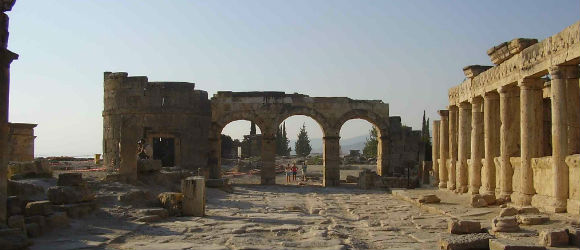The presence of a hot spring at Hierapolis and the spectacular calcium deposits from its water spilling over the nearby hillside suggest that there should be evidence of an early settlement there. The oldest Inscription found so far, however, indicates it was founded by Eumenes II, king of Pergamon, in the latter part of the second century B.C.; it soon became a busy industrial center.
Pagan worship in the city centered around Cybele, Apollo, Artemis, Men, Poseidon, and Pluto. Underneath the Temple of Apollo has been found the Plutonium, an opening in the earth from which a noxious gas still comes. The temple is between the pool where the hot spring rises and the large theater on the side of the hill. To the north along the rim of the plateau is a long avenue of tombs.
Traditionally St. Philip is connected with the early church in Hierapolis. Fairly recently Italian archeologlsts have discovered his Martyrium, an octagonal chamber forming a double cross surrounded by a square. This is almost due north of the theater, also on the side of the hill. It was a fifth century A.D. building and did not last much more than 100 years. No tomb was found with it although that was expected. There are several ruins of churches, one not far from the baths, one on the main road leading to the necropolis.
Hierapolis is listed in the New Testament along with Laodicea as the center of Epaphras’s work (Colos-sians 4:13). This was at the time Paul was writing to strengthen the message Epaphras was preaching and to condemn the “people who go in for self-mortification and angel-worship” (Colossians 2:18). Another less well-known resident of Hierapolis was Papias, a disciple of St. John and the author of the lost book called the Sayings of Jesus.
While Epaphras was is that area, a young slave was growing up in Hierapolis, a boy whose original name is unknown but whom we call by the Greek for “Acquired”, Epictetus. In his Discourses Epictetus often talks about the perfect missionary whose bed was the ground, whose only house the earth and sky and a shabby cloak, and who must love those who misuse him in the service of God. One wonders what the influence of those early Christians, many of whom were slaves themselves, was on this Stoic philosopher.
Hierapolis,


To visit Pamukkale and also the old town of Hierapolis is very nice. Was one of our highlights in Turkey.
For Pamukkale see the reviews.
In Hierapolis are many remains from Greece and Roman civilisation. The great theater is the top.
The trip was very long and the attraction was really ok but too crowded. I would really not have gone for that money…
Hierapolis, in Pamukkale, is well worth the visit. There are so many ruins that it is almost unbelievable, and you stroll past Roman column pieces as though they were just detritus.
The Cotton Castle of Pamukkale is a site to be visited and experience. This was one of our best sites on our Turkey tour. The place is located in…
We stayed in pamukkale 10th October in Turkey.
The whole city looks rundown and not worth to travel there and stay at all.
You see the" cotton castle " better on the pictures and postcards.
Entrance 20 lira and you walk upto the travertines but they charge u 25 lira more for the pool ( full of Russians and noisy…
Great history, and you cannot go to Antalya and not visit these historical place. nothing that I did not like. As a family we appreciate History and therefore will recommend, to choose your tours and this you can do with no problems from the Hotel or various tour operators. Different rates can be found.
Spent four hours touring the ruins of hierapolis and wetting our feet in the cooton castle and love to have spent many, many more. Took a huge number of photos that simply cant do it justice.
We were very lucky when we visited the site, as there was a concert starting in the ancient amphitheatre and it was amazing to…
I traveled to Pamukkale & Hierapolis with Nirvana travels during my holiday in Antalya. This place is absolutely breathtaking! If you're interested in history, or if you like to bathe your feet in some hot thermal water, this is the place to be.
The tavertines looks like mountains made out of snow, and the ancient roman theater is just a…
Very interesting site with lots of history–wear good walking shoes
The white travertine terraces and thermal pools are magnificent.Cleopatras sacred pool was crowded but I still enjoyed the warm mineral waters
Visited on a very hot Sunday afternoon – lots to see and an opportunity to walk in the spa waters at the Pamukkale site. Good signposting and shop/museum. Take bottled water and wear comfortable shoes!